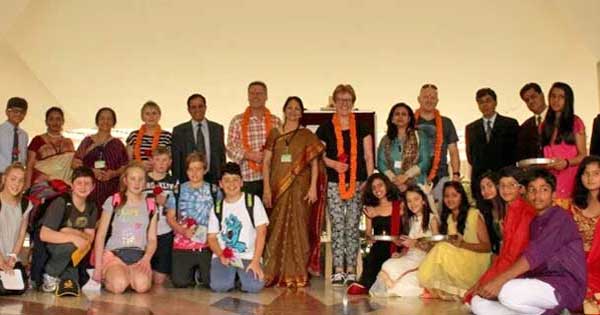Jain International Residential School (JIRS), Bangalore and Kalinda Primary School, Melbourne, are in a Student Exchange Partnership Programme since 2013. Recently, a team of students and teachers from Kalinda Primary School visited JIRS as part of the programme. We quizzed, Steve Harvey, the physical education teacher about his thoughts and opinions on JIRS.
As a faculty member who took part in the Student Exchange Programme, tell us about your experience at Jain International Residential School, Bangalore.
The experience of travelling to JIRS, and Karnataka (India), was one that I will never forget. I saw things, smelt things, heard things and tasted things that (my predominantly conservative) life in Australia simply doesn’t get near! When describing the experience to family, friends and colleagues I speak of the intensity of life outside the JIRS walls, and then the peaceful spirit and order of life within them. Every amazing ‘excursion’ was like a military operation in which we were swiftly immersed into the day-to-day life of Karnataka, only to be rescued just as the experience threatened to throw us into sensory overload! It was perfect! I was (and remain) awed by the country’s rich history, it’s colours and the ebbs and flows of the rural energy of the area surrounding JIRS as ‘the daily grind’ builds to fever-pitch but then throttles back to a purr as family & community life takes priority into the evening.
However, my continuing memory of the experience is the people of JIRS. I have photographs scrolling on-screen in the living room of my home, and even pictures of stunning landscapes or landmarks simply remind me of the people I was sharing those moments with.
The children of JIRS are simply beautiful. Polite, gracious and well mannered, with a spirit for life that glimmers in their eyes and curls (up) the sides of their mouth.
How does the Student Exchange Programme help the students and teachers?
They may not be aware of it, or be able to articulate it (yet), but the seven Kalinda Primary School students who were fortunate to be able to visit JIRS during August and September of 2015 benefited by (amongst others):
- Increased general, international knowledge which will have promoted acceptance and understanding of Indian cultural and its community perspectives; and
- improved maturity, social poise, self-development and self-awareness; fuelled by the necessity to confront challenges outside a familiar support network and comfort zone.
As a teaching professional within Victoria’s Department of Education and Early Childhood Development, and as the Physical Education Teacer and Facilities Manager of Kalinda Primary School, I benefited greatly from my time at JIRS by (amongst others):
- exchanging ideas and knowledge;
- broaden my educational horizon/s through a ‘forced’ global perspective;
- constantly reflecting and reappraising my own teaching practices and education philosophy; and
- broadening my own ‘bank’ of personal experiences by travelling and experiencing a vastly different community and culture.
Since my return to Australia, I would hope that I have also contributed to the professional development of my Australian teaching colleagues (and my family and friends) by sharing the experience and knowledge gained while away.
How do you evaluate the Indian educational system?
Bearing in mind that my only exposure to the ‘Indian Education System’ is JIRS, it is difficult to believe that I have a balanced view of the system in its entirety.
What are your observations on the pedagogy followed by JIRS?
My observations on the pedagogy followed by JIRS include that:
- The staff (most particularly management and teaching staff – with whom we spent the most time), demonstrated that they are committed, compassionate, dependable, individually perceptive (i.e. sees each student as a unique and valuable individual – this was a huge strength), hugely knowledgeable, motivational, organised, patient, personable (& collaborative), positive, humorous and value-based.
- The learning environments were productive (and supportive in the provision of remedial instruction classes).
- The learning programme was strongly connected with theories and practices well beyond the classroom, but also reflected student needs, backgrounds, perspectives and interest.
- Assessment is an integral part of learning and teaching.
In one particular discussion that I enjoyed, I was surprised that the terms ‘visible learning intentions and success criteria’ came up (completely unprompted). The regular reference back to educating ‘the whole child’ based upon strong school values also made me feel that I had been transplanted into the Indian incarnation of Kalinda Primary School. In many ways, and for all of the differences between us, the similarities between our schools are startling!


